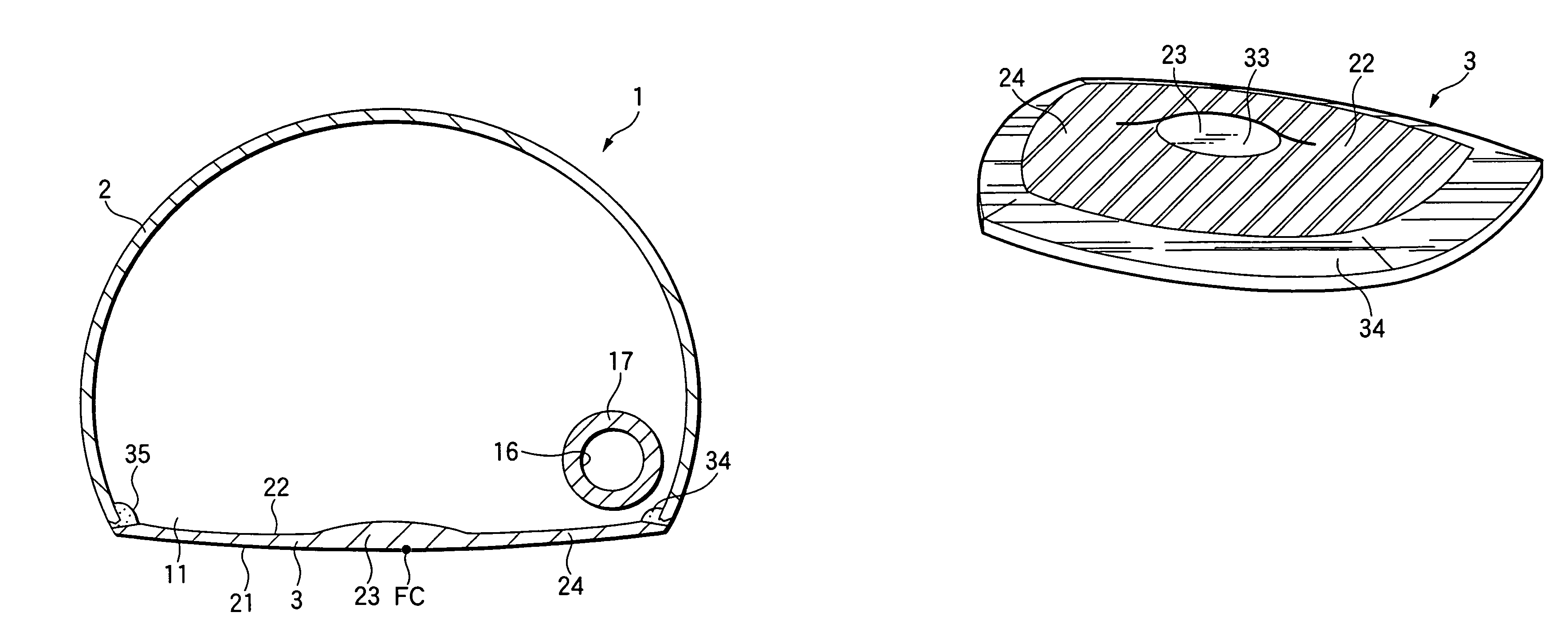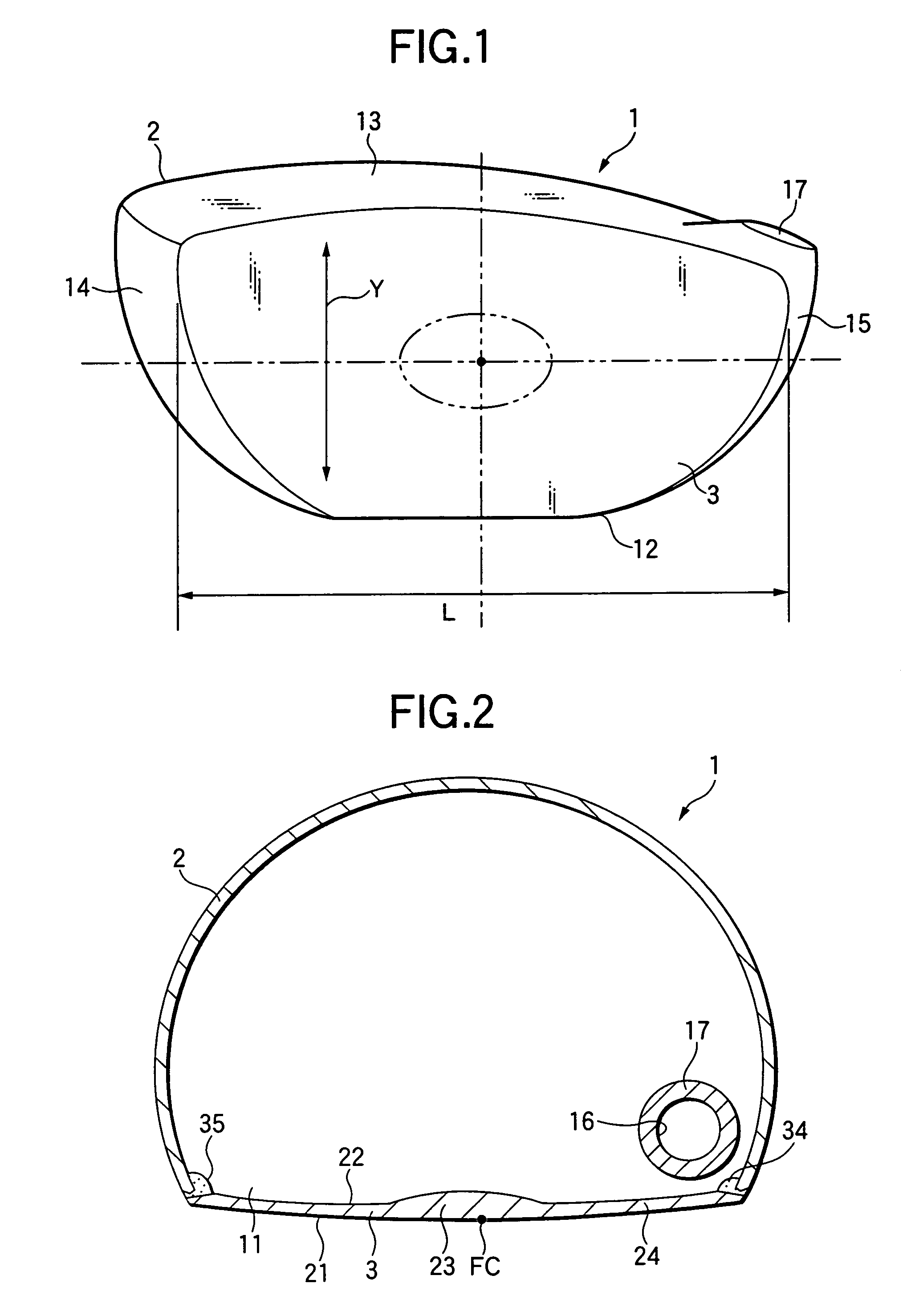Golf club head and method of manufacturing the same
a technology of golf club head and manufacturing method, which is applied in the field of golf club head, can solve the problems of insufficient strength of the central portion of the face for directly hitting the ball, difficult to form a stable striking surface, and inability to plan the respective dimensions and strengths, etc., to achieve the effect of increasing the flying distance of the ball, enhancing repellency, and sufficient strength
- Summary
- Abstract
- Description
- Claims
- Application Information
AI Technical Summary
Benefits of technology
Problems solved by technology
Method used
Image
Examples
first embodiment
[0067]FIGS. 1 to 4 show a golf club head of a wood type which is a metallic hollow head in accordance with a first embodiment of the invention.
[0068]This golf club head 1 has a head body 2 formed by a hollow member, and a face member 3 for forming a face. As shown in FIG. 2, an opening 11 is formed in the head body 2 on the face side. With the golf club head 1, a lower surface portion of the head body 2 is formed as a sole 12, an upper surface portion thereof is formed as a top 13, and left- and right-hand portions of the face member 3 are respectively formed as a toe 14 and a heel 15. A shaft securing portion 17 having a shaft securing hole 16 for attaching an unillustrated club shaft is formed on the heel 15 side.
[0069]The face member 3 is disposed at the opening 11 of the aforementioned head body 2. The shape of the face member 3 is that of a contour conforming to the shape of the opening 11 of the head body 2, as shown in FIG. 2. The face member 3 is fixed to the head body 2 by ...
second embodiment
[0080]FIG. 5 shows a golf club head in accordance with a second embodiment of the invention. In the golf club head 1 in accordance with this embodiment, when the reverse surface 22 of the face member 3 is shaved down by shaving, the portion of the thick-walled portion 23 in the central area is processed into the shape of a top portion which is not flat but rounded. According to this embodiment, since the thick-walled portion 23 and the thin-walled portion 24 continue smoothly at their boundary, the stress does not concentrate in the boundary, and the overall strength of the face member 3 increases.
third embodiment
[0081]FIG. 6 shows a golf club head in accordance with a third embodiment of the invention. In the golf club head 1 in accordance with this embodiment, when the reverse surface 22 of the face member 3 is shaved down by shaving, machining is effected over the area covering the thick-walled portion 23 in the vicinity of the face center FC and the thin-walled portion 24 surrounding it, such that the flat top portion is not left, and the overall reverse surface 22 is cut into a rounded gentle shape. In this embodiment as well, since the thick-walled portion 23 and the thin-walled portion 24 continue smoothly at their boundary, the stress does not concentrate in the boundary, and the overall strength of the face member 3 increases.
[0082]Further, although not shown, the overall reverse surface 22 may be processed into a conical shape in which it is pointed in the vicinity of the center of the thick-walled portion 23.
[0083]It should be noted that, as the processing method for forming the t...
PUM
| Property | Measurement | Unit |
|---|---|---|
| thickness | aaaaa | aaaaa |
| thickness | aaaaa | aaaaa |
| thickness | aaaaa | aaaaa |
Abstract
Description
Claims
Application Information
 Login to View More
Login to View More - R&D
- Intellectual Property
- Life Sciences
- Materials
- Tech Scout
- Unparalleled Data Quality
- Higher Quality Content
- 60% Fewer Hallucinations
Browse by: Latest US Patents, China's latest patents, Technical Efficacy Thesaurus, Application Domain, Technology Topic, Popular Technical Reports.
© 2025 PatSnap. All rights reserved.Legal|Privacy policy|Modern Slavery Act Transparency Statement|Sitemap|About US| Contact US: help@patsnap.com



